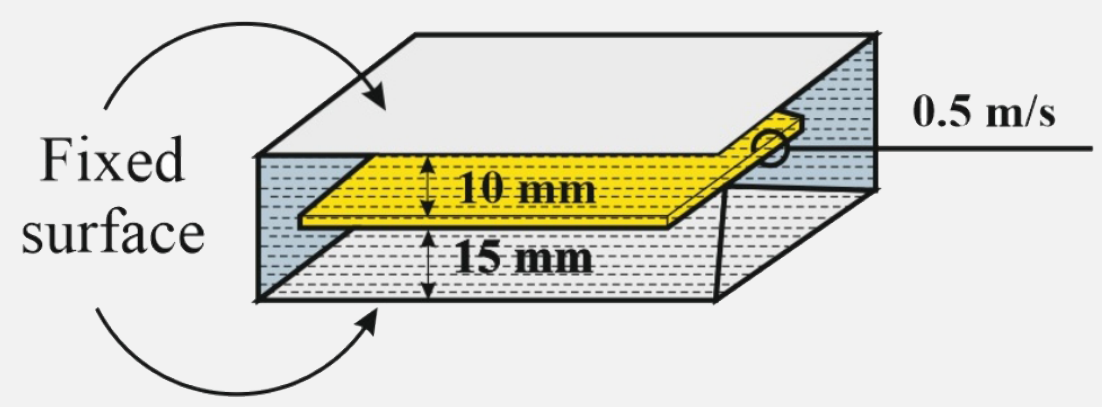
A space 2.5cm wide between two large plane surfaces is filled with oil. Force required to drag a very thin plate of area 0.5m2 just midway the surfaces at a speed of 0.5msec is 1N. The coefficient of viscosity in kg−sm2 is:
5×10−2
2.5×10−2
1×10−2
7.5×10−2
The correct Answer is:B
Velocity gradient =0.52.52×10−2
as force on the plate due to viscocity is from upper as well as lower portion of the oil, equal from each part,
ThenF=2ηAdvdz=2×η×(0.5)0.51.25×10−2

⇒η=2.5×10−2kg−sec/m2
Topper's Solved these Questions
- BOOK - RESONANCECHAPTER - FLUID MECHANICSEXERCISE - Examples22videos
FLUID MECHANICS
- BOOK - RESONANCECHAPTER - FLUID MECHANICSEXERCISE - Board Level Exercise18videos
FLUID MECHANICS
- BOOK - RESONANCECHAPTER - ELECTROSTATICSEXERCISE - Exercise52videos
ELECTROSTATICS
- BOOK - RESONANCECHAPTER - FULL TEST 1EXERCISE - Exercise30videos
FULL TEST 1
Similar Questions
Glycerine is filled is 25mm wide space between two large plane horizontal surfaces. Calculate the force required to drag a very thin plate 0.75m2 in area between the surface at a constant speed of 0.5m/s if it is at a distance of 10mm from of the surfaces in horizontal position? Take coefficient of viscosity η=0.5Ns/m2. Fill the value of X where X= force required to drag/6.25
 View Solution
View SolutionA force of 3.14N is required to drag a sphere of radius 4cm with a speed of 5ms−1 in a medium in gravity free space. Find the coefficient of the viscosity of the medium.
View Solution
Knowledge Check
- Question 1 - Select One
The space between two large plane surfaces is 2.5 cm and it is filled with glycerine.
What force is required to drag a very thin plate 1m2 in area, between the surfaces at a speed of 1m/s ? (The plate is at a distance of 1 cm from one of the surfaces. ) (η=0.75Ns/m2)A100 NB75 NC50ND125 N - Question 2 - Select One
The force of 2000 dyne is required to move a flat glass plate of surface area 10cm2 with a velocity of 1 cm/s over a surface of glycerine 1 mm thick. The coefficient of viscosity of glycerine is
A0.2 poiseB0 poiseC20 poiseD20.5 poise - Question 3 - Select One
A metal plate of area 500cm92) is kept on a horizontal surface with a layer of oil of thickness 0.5 mm between them. The horizontal force required to drag the plate with a velocity of 2 cm/s is
(coefficient of viscosity =0.9 kg/ms)A180 NB18 NC0.018 ND1.8N
Glycerine is filled in 25 mm wide space between two large plane horizontal surfaces. A thin plate of area 0.75m2 at a distance of 10 mm from one of the surfaces is in a horizontal position be the plates inside the glycerine. It is dragged horizontally at a constant speed of 0.5ms2. Take coefficient of viscosity η= 0.5 Ns m−2. What is the force required to drag the plate at a constant speed (in newton) ?
 View Solution
View SolutionFind the minimum force required to drag a hard polythene plate of area 2m2 on a thin film of oil of thickness 0.25cm and η=15 poise. Assume the speed of the plate is 10cms−1.
View SolutionThere is a 1 mm thick layer of oil between a flat plate of area 10−2m2 and a big plate. How much force is required to move the plate with a velocity of 1.5cm/s. The coefficient of viscosity of oil is 1 poise
View Solution
A rectangular metal plate has dimensions of 10cm×20cm. A thin film of oil separates the plate from a fixed horizontal surface. The separation between the rectangular plate and the horizontal surface is 0.2mm. An ideal string is attached to the plate and passes over an ideal pulley to a mass m. When m=125gm, the metal plate moves at constant speed of 5cms, across the horizontal surface. Then the coefficient of viscosity of oil in dy≠−scm2 is (Use g=1000cms2)View SolutionThe surface tension of a liquid is 0.5 N/m . If a liquid film is formed on a ring of area 0.02 m2 then its surface energy will be
View Solution

